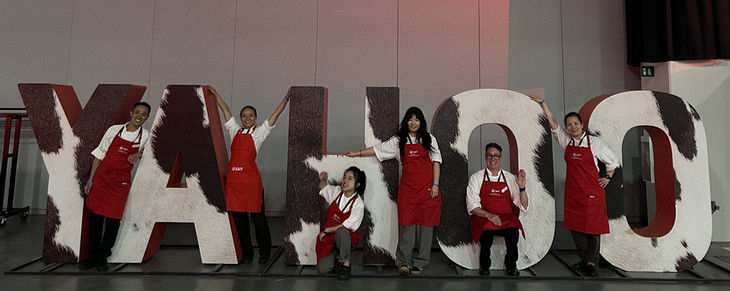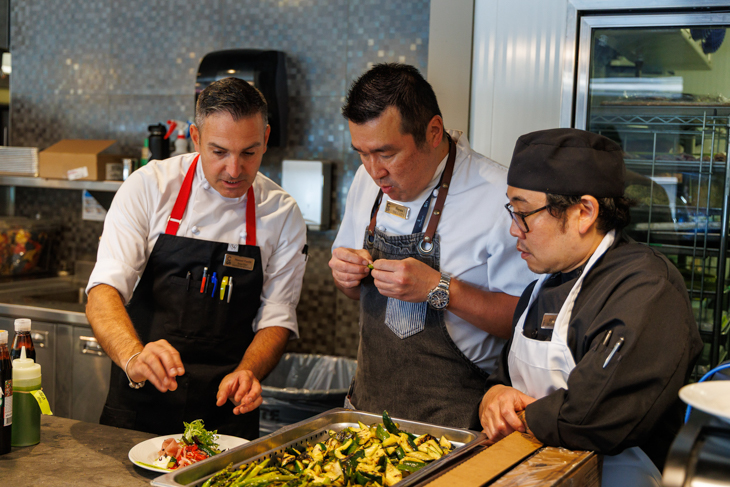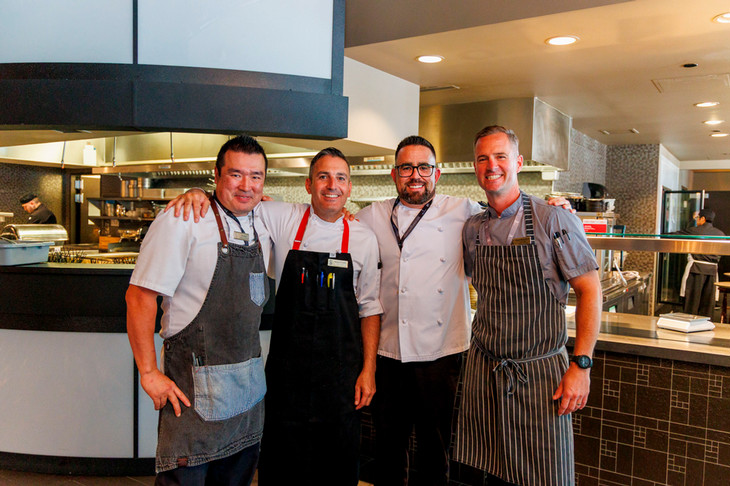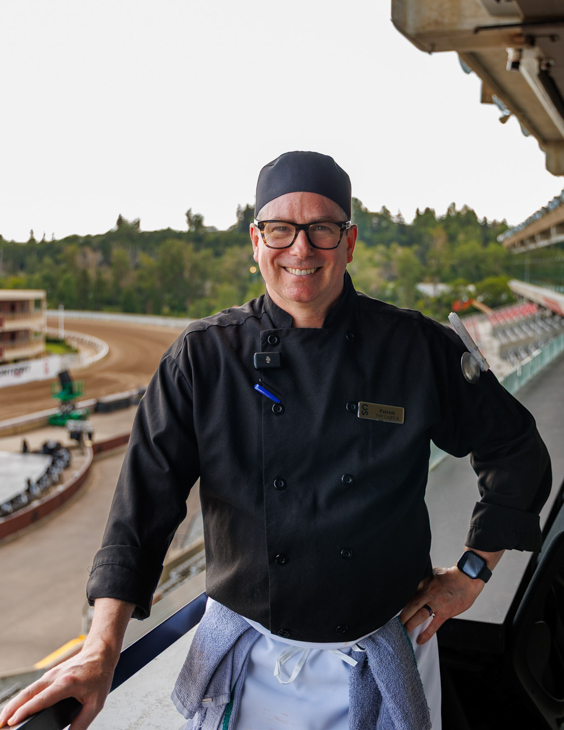SAIT and Calgary Stampede represent the past, present and future of hospitality

Two organizations working together to serve up a strong future for Calgary’s hospitality industry
There are few things in Calgary with roots as deep as SAIT, but the Greatest Outdoor Show on Earth is one of them.
When Guy Weadick organized the first rendition of the Calgary Stampede in 1912, it was four years before SAIT opened its doors as the Provincial Institute of Technology and Art to help retrain local First World War veterans. Thirty-four years later, a cooking class launched what would become our international-ranked School of Hospitality and Tourism.
As we celebrate 75 years of hospitality and tourism at SAIT, we’re tipping our hats to the longstanding collaborative relationship the School of Hospitality and Tourism has shared with our slightly older and undeniably iconic industry partner (howdy 🤠).
When folks think of the Calgary Stampede, they conjure visions of Midway snacks, rides and rodeo. But the 10-day exhibition of rodeo, entertainment and agriculture is one of many exciting events held throughout the year at the elaborate downtown facilities, making it an ideal training ground for students studying in SAIT’s hospitality, tourism and culinary programs.
 “It’s such a small community and I think our organizations are fairly similar — we’ve had such great collaboration from the start and continue to have that,” says Derek Dale, Academic Chair of Culinary Programs at the School of Hospitality and Tourism.
“It’s such a small community and I think our organizations are fairly similar — we’ve had such great collaboration from the start and continue to have that,” says Derek Dale, Academic Chair of Culinary Programs at the School of Hospitality and Tourism.
And Dale would know. He joined SAIT in 2023 after working for 36 years at Calgary Stampede, where he held the prestigious role of Executive Chef for nearly 30 years.
“I graduated from SAIT and began working at the Stampede just before the 1988 Olympics, and there were a lot of SAIT instructors who came and worked with Stampede to support the global event — it was great learning to actually work alongside them,” says Dale.
In 2008, Dale launched the Grown Right. Here. initiative to spotlight locally sourced ingredients on the Stampede’s menu. In 2020 and 2021, he spearheaded Calgary Stampede’s partnership with La Tablée des Chefs, which led to over 200,000 meals distributed to those in need during the pandemic.
“It’s a huge circle for me, graduating from SAIT in 1987 to working at Calgary Stampede and now at working at SAIT. It’s giving back to students and being able to show them how Calgary Stampede plays an integral part in Calgary and always will be — that’s the beauty of the organization,” says Dale.
An ideal example of education and industry collaborating to benefit learners was Calgary Stampede’s internship program, the Wild West Chefs. SAIT culinary students could earn food service hours as they developed their skills at the Stampede’s premium venues. Over the three-month program, students were exposed to all aspects of the organization’s food and beverage program, experiencing everything from plated dinners to VIP service.
“To see the entire industry in one place, from quick service to a high-end experience, Stampede encompasses it all. Our students gain immense experience from partnerships like the one we share with Calgary Stampede,” says Dale.
This year, we were given the opportunity to chat with Sharon Garnett, Director of Food and Beverage at the Calgary Stampede, and take a behind-the-scenes look at the kitchen servicing the executive suites at the Lazy S, where patrons share an elevated culinary experience while watching the Stampede Rodeo or Evening Show.

Garnett, who is overseeing food and beverage services at her 41st Calgary Stampede, joined the organization as a frontline employee in hospitality service and has built an impressive career centered around food and beverage. From monumental moments like the ’88 Olympics to the 2013 flood that saw Calgary’s downtown under water less than a month before the 10-day festival, she’s seen the organization through it all.
“Over the years, I think our partnership has benefitted both students and us as an organization. We’ve reached out to SAIT’s hospitality team for different seasons when we needed extra staff, taking on students for four to five weekends. We put them into real life situations working events and earning a wage. It really gave them good boots-on-the-ground experience.”
The culinary connection between the two organizations is impressive — walking into the Lazy S felt like an on-campus culinary lab, where we were greeted by multiple SAIT chef instructors, students and alumni working in Calgary Stampede chef whites.

“The SAIT students who come to work here are engaged and great. Basically, if somebody comes to us as a student at SAIT, we hire them. They get that hands-on experience, which is really relevant when they get into the workforce, and we show them what large-scale hospitality looks like. I love that the students that come here to work really do have that service heart,” says Garnett.
The instructors who return to work at the Calgary Stampede every year during the break in their teaching schedule are a testament to the collaborative nature between the two organizations, and the importance of bringing mentorship off-campus and directly into industry. They set an example for new employees who are getting their start at the Calgary Stampede.
“I think that’s really important. They are representing not only their school, but the hospitality industry as well. They set an example of the work ethic required and an understanding of the Stampede mentality and culture.
“We trust SAIT programs and that we’re getting talented people out of the school... students come out with good skills and are committed to the industry. Our chef is very excited when a SAIT student wants to come and work here because we are building a shared success,” says Garnett.
 Patrick Creery has completed his first year of SAIT’s Culinary Arts program and joined the team working at Lazy S during Stampede.
Patrick Creery has completed his first year of SAIT’s Culinary Arts program and joined the team working at Lazy S during Stampede.
“This is the kind of connection SAIT has. It’s the chef instructors who work here for the Stampede, they’re teaching and working in the industry. I’m here with instructors I’ve learned from and it’s nice to work with them in a professional capacity,” says Creery.
“I’m excited for anything that’s new. That’s part of why this is great – it’s new. I get to work in a kitchen with new people, and work on my soft skills and management skills and culinary skills. I like that you get this concentrated experience. Once you’ve been through that, it’ll give you confidence going back into anything high volume, school or your next job.”
Taking collaboration out of the kitchen
SAIT’s School of Hospitality and Tourism recently created a professional advisory committee where industry partners like the Calgary Stampede provide important insight that ensures our programming is relevant and future-focused, bridges the gap between classroom and career, and allows our learners to build skills in a real-world context. Our work with industry is the cornerstone to understanding and responding to emerging workforce trends, our success and the success of our learners.
“Because of that long-standing relationship and folks that have worked here, we see that pipeline of talent growing, and it’s important that we grow the relationship and the programs,” say Garnett.
Dale echoes a similar sentiment. “Forming that collaboration and partnership has never been one-sided — it’s a win for SAIT and a win for Calgary Stampede,” says Dale. “The youth mentorship opportunities and programs we could potentially build through this partnership down the road — there’s always opportunity. Education is inspiring and brings everyone together. At the end of the day, we want to be a solution to make sure that the industry has what it needs to continue building hospitality.”


Oki, Âba wathtech, Danit'ada, Tawnshi, Hello.
SAIT is located on the traditional territories of the Niitsitapi (Blackfoot) and the people of Treaty 7 which includes the Siksika, the Piikani, the Kainai, the Tsuut’ina and the Îyârhe Nakoda of Bearspaw, Chiniki and Goodstoney.
We are situated in an area the Blackfoot tribes traditionally called Moh’kinsstis, where the Bow River meets the Elbow River. We now call it the city of Calgary, which is also home to the Métis Nation of Alberta.